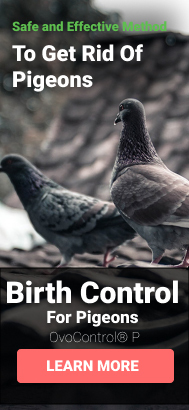Bird Control in Buildings: The Most Effective Methods
Written by Erick Wolf
Bird control in buildings has become an essential part of facility management. The presence of birds, particularly in government buildings, can lead to several challenges, ranging from property damage to increased maintenance costs and health risks.
In this article, we’ll discuss the importance of bird control in buildings as well as provide examples of how to get pigeons out of a building through effective methods on the market today.
The Importance of Bird Control in Buildings
Bird control in buildings is of paramount importance due to a multitude of reasons:
Equipment Damage
Birds, particularly pigeons, are notorious for building nests in machinery or HVAC systems. This can lead to malfunctions, costly repairs, and even the risk of electrical issues.
Property Damage
Bird droppings and nesting materials can cause significant damage to building surfaces, including ledges, parapet roofs, signage, rooftops, parking structures, and loading docks.
Increased Maintenance Costs
The continuous cleaning and repair associated with bird presence can lead to increased maintenance costs for the property.
Noise and Disturbance
The noise created by a large flock of birds can be a significant disturbance, particularly in a professional setting.
Health and Sanitation Risks
Bird droppings can carry diseases, posing a potential health risk to occupants.
Slip and Fall Hazards
Accumulated bird droppings can make surfaces slippery, leading to potential slip and fall hazards.
Potential Liability and Penalties
Inadequate bird control can lead to potential liability and penalties under various health and safety regulations.
Birds are attracted to buildings and structures for a variety of reasons, including the availability of food, water, and shelter. Therefore, implementing effective bird control methods is crucial to maintaining a clean and safe environment.
Proven Bird Control Strategies for Buildings
You might be wondering how to get a bird out of a building. Thankfully, several proven strategies can be effective in bird control for buildings:
Bird Birth Control
Bird birth control, like the product OvoControl, interferes with the ability of bird eggs to hatch. It can be an effective and humane solution for larger areas where some pigeons can be tolerated but a reduction in population is needed. More on this will be discussed in a later section.
Laser Deterrents
Laser deterrents have been shown to be highly effective at deterring birds. A study showed that when a laser deterrent was used, it was 99.7% effective at preventing waterfowl from the observed range and 96% effective for other bird species.
Bird Netting
Bird netting is a common method used for bird control in buildings. It involves installing nets in areas where birds are likely to nest or perch. However, while this strategy can deter birds from specific areas, it is generally considered a temporary solution and may not be fully effective in large-scale bird infestations.
Furthermore, birds can sometimes get caught in the netting, leading to potential harm. Bird netting does not address the root of the problem like bird birth control does and requires regular maintenance and replacement for continued effectiveness.
Bird Spikes and Wires
Bird spikes and wires are physical deterrents installed on ledges, beams, and other surfaces to prevent birds from landing and roosting. However, these methods can detract from the aesthetic appeal of the building and are only effective in the specific areas where they are installed. Also, they do not offer a long-term solution to bird infestation and require regular maintenance.
Like bird netting, they don't address the issue of bird reproduction, which is effectively managed by bird birth control.
Bird Slopes
Bird slopes are physical deterrents that prevent birds from gaining a foothold on ledges and other surfaces. They are usually installed at an angle that makes it difficult for birds to land.
However, their effectiveness is limited to the areas where they are installed, and they are not suitable for all types of surfaces or architectural designs. They also don't address the issue of bird reproduction, which bird birth control effectively manages.
Bird Gel
Bird gel is a sticky substance that can be applied to ledges and other surfaces where birds like to perch. It creates an uncomfortable surface for birds, discouraging them from landing. However, bird gel can require regular reapplication, particularly in areas with high weather exposure.
Additionally, it can inadvertently trap smaller creatures and insects, leading to unintended harm. Unlike bird birth control, bird gel does not manage the root cause of bird infestations — reproduction.
Bird Deterrent Sound System
A bird deterrent sound system uses distress calls and predator sounds to scare away birds. However, these systems have limited effectiveness depending on the sound range, the bird species, and their acclimatization to the sounds.
Additionally, these sounds can be disturbing to people in the vicinity and may not be suitable for all settings. Sound systems do not address the issue of bird reproduction, a problem effectively solved by bird birth control.
Electric Bird Deterrents
Electric bird deterrents deliver a small shock to birds that attempt to land on treated surfaces, effectively discouraging them from roosting in those areas. While these systems can be effective, they are often seen as inhumane due to the discomfort caused to the birds. They also require a power source and regular maintenance, increasing their overall costs.
Electric deterrents do not manage bird populations at their core — through reproduction — which is what bird birth control achieves.
Why Use OvoControl for Bird Control in Buildings?
OvoControl is a leading solution for bird control in buildings. This innovative technology was developed in collaboration with USDA/APHIS and effectively acts as birth control for pigeons. The technology interferes with the ability of pigeon eggs to hatch, leading to a reduction in the bird population over time.
OvoControl is environmentally friendly, non-lethal, and humane. It is designed to be fed to birds during the reproductive season. The product is fed to the birds through a controlled baiting system that virtually eliminates any impact on non-target birds.
The effects of OvoControl are fully reversible. Furthermore, the hatchability of eggs from a bird of prey, such as a falcon, is not at risk by consuming treated pigeons. This technology complements other bird management techniques, such as habitat modification, physical barriers, and hazing methods.
Final Thoughts
In conclusion, bird control in buildings is an essential part of facility management. Various effective methods are available, including landscape alterations, physical barriers, property maintenance and sanitation, sensory overload methods, bird birth control, and laser deterrents. Combining these strategies makes it possible to significantly reduce the presence of birds and mitigate the associated challenges.





